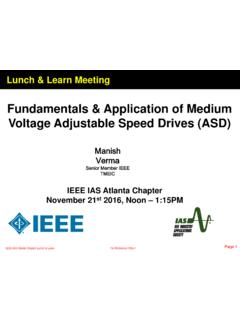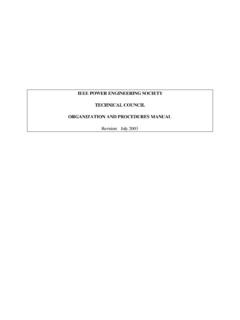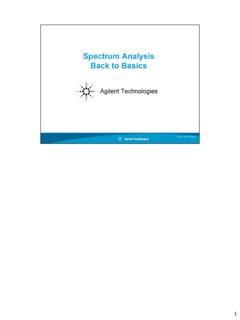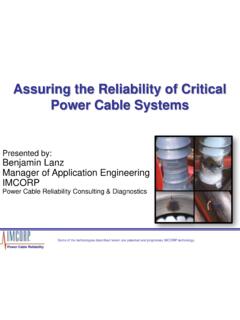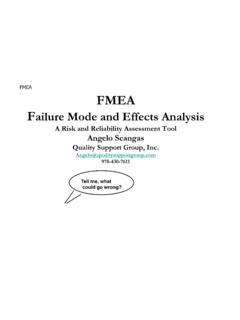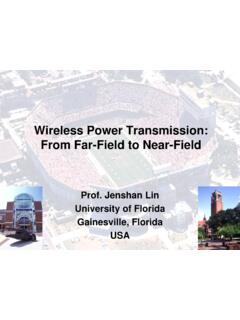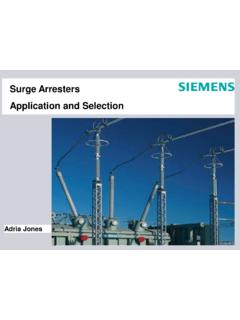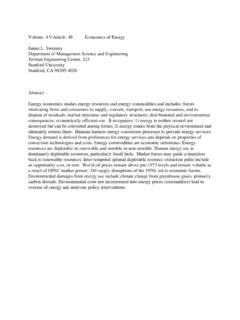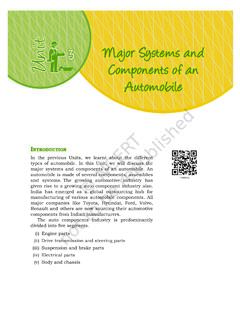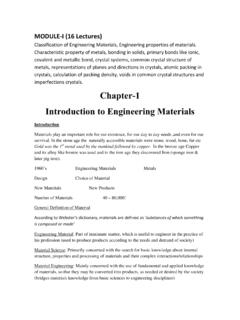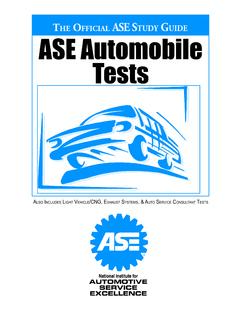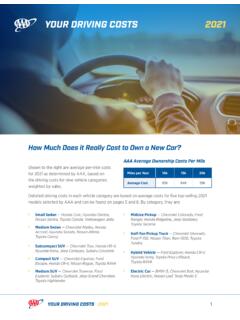Transcription of 8. FEEDBACK CONTROL SYSTEMS - Institute of Electrical and ...
1 FEEDBACK CONTROL - FEEDBACK CONTROL INTRODUCTIONE very engineered component has some function. A function can be described as a transformation of inputs to outputs. For example it could be an amplifier that accepts a sig-nal from a sensor and amplifies it. Or, consider a mechanical gear box with an input and output shaft. A manual transmission has an input shaft from the motor and from the shifter. When analyzing SYSTEMS we will often use transfer functions that describe a sys-tem as a ratio of output to TRANSFER FUNCTIONST ransfer functions are used for equations with one input and one output variable. An example of a transfer function is shown below in Figure The general form calls for output over input on the left hand side. The right hand side is comprised of constants and the D operator. In the example x is the output, while F is the input. Figure transfer function exampleTopics:Objectives: To be able to represent a CONTROL system with block diagrams. To be able to select controller parameters to meet design objectives.
2 Transfer functions, block diagrams and simplification FEEDBACK controllers CONTROL system designoutputinput-----------------fD()=T he general formxF---4D+D24D16++-------------------- -------------=An examplefeedback CONTROL - both sides of the example were inverted then the output would become F , and the input x . This ability to invert a transfer function is called reversibility. In reality many SYSTEMS are not reversible. There is a direct relationship between transfer functions and differential equations. This is shown for the second-order differential equation in Figure The homogeneous equation (the left hand side) ends up as the denominator of the transfer function. The non-homogeneous solution ends up as the numerator of the relationship between transfer functions and differential equations for a mass-spring-damper exampleThe transfer function for a first-order differential equation is shown in Figure As before the homogeneous and non-homogeneous parts of the equation becomes the denominator and the numerator of the transfer 2 nx n2x++fM-----=xD22 nxD n2x++fM-----=xD22 nD n2++()fM-----=xf--1M----- D22 nD n2++------------------------------------ --------=particularhomogeneous n Natural frequency of system - Approximate frequency ofcontrol system factor of system - If < 1 then underdamped, and the systemwill oscillate.
3 If =1 critically damped. If < 1 overdamped, and neverany oscillation (more like a first-order system). As damping factorapproaches 0, the first peak becomes infinite in CONTROL - first-order system CONTROL SYSTEMSF igure shows a transfer function block for a car. The input, or CONTROL variable is the gas pedal angle. The system output, or result, is the velocity of the car. In standard operation the gas pedal angle is controlled by the driver. When a cruise CONTROL system is engaged the gas pedal must automatically be adjusted to maintain a desired velocity set-point. To do this a CONTROL system is added, in this figure it is shown inside the dashed line. In this CONTROL system the output velocity is subtracted from the setpoint to get a system error. The subtraction occurs in the summation block (the circle on the left hand side). This error is used by the controller function to adjust the CONTROL variable in the system. Negative FEEDBACK is the term used for this type of controller.
4 X 1 ---x+f=xD1 ---x+f=xD1 ---+ f=xf--1D1 ---+-------------= FEEDBACK CONTROL - automotive cruise CONTROL systemThere are two main types of FEEDBACK CONTROL SYSTEMS : negative FEEDBACK and pos-itive FEEDBACK . In a positive FEEDBACK CONTROL system the setpoint and output values are added. In a negative FEEDBACK CONTROL the setpoint and output values are subtracted. As a rule negative FEEDBACK SYSTEMS are more stable than positive FEEDBACK SYSTEMS . Negative FEEDBACK also makes SYSTEMS more immune to random variations in component values and CONTROL function in Figure can be defined many ways. A possible set of rules for controlling the system is given in Figure Recall that the system error is the difference between the setpoint and actual output. When the system output matches the setpoint the error is zero. Larger differences between the setpoint and output will result in larger errors. For example if the desired velocity is 50mph and the actual velocity 60mph, the error is -10mph, and the car should be slowed down.
5 The rules in the figure give a gen-eral idea of how a CONTROL function might work for a cruise CONTROL system. INPUT( gas)SYSTEM( a car)OUTPUT( velocity) CONTROL variablevdesiredverror+_controlcarvactua l gasNote: The arrows in the diagram indicate directions so that outputs and inputs are unambiguous. Each block in the diagram represents a transfer CONTROL - CONTROL rulesIn following sections we will examine mathematical CONTROL functions that are easy to implement in actual CONTROL PID CONTROL SystemsThe Proportional Integral Derivative (PID) CONTROL function shown in Figure is the most popular choice in industry. In the equation given the e is the system error, and there are three separate gain constants for the three terms. The result is a CONTROL variable PID controller equationFigure shows a basic PID controller in block diagram form. In this case the potentiometer on the left is used as a voltage divider, providing a setpoint voltage. At the output the motor shaft drives a potentiometer, also used as a voltage divider.
6 The voltages from the setpoint and output are subtracted at the summation block to calculate the feed-back error. The resulting error is used in the PID function. In the proportional branch the error is multiplied by a constant, to provide a longterm output for the motor (a ballpark guess). If an error is largely positive or negative for a while the integral branch value will become large and push the system towards zero. When there is a sudden change occurs in the error value the differential branch will give a quick response. The results of all three branches are added together in the second summation block. This result is then amplified to drive the motor. The overall performance of the system can be changed by adjusting the gains in the three branches of the PID rules to CONTROL car (also like expert system/fuzzy logic):1. If verror is not zero, and has been positive/negative for a while, increase/decrease gas2. If verror is very big/small increase/decrease gas3. If verror is near zero, keep gas the same4.
7 If verror suddenly becomes bigger/smaller, then increase/decrease etc. uKpeKiedt Kddedt------ ++= FEEDBACK CONTROL - PID CONTROL systemThere are other variations on the basic PID controller shown in Figure A PI controller results when the derivative gain is set to zero. (Recall the second order response.) This controller is generally good for eliminating long term errors, but it is prone to overshoot. In a P controller only the proportional gain in non-zero. This controller will generally work, but often cannot eliminate errors. The PD controller does not deal with longterm errors, but is very responsive to system other CONTROL equationsVV+-ampmotor+++proportionalinte gralderivativeKie ()Kpe()Kdddt-----e PID functionue+V-V gasKpverrorKiverrordt += gasKpverror= gasKpverrorKddverrordt---------------- +=For a PI ControllerFor a P ControllerFor a PD Controllerfeedback CONTROL - Manipulating Block DiagramsA block diagram for a system is not unique, meaning that it may be manipulated into new forms.
8 Typically a block diagram will be developed for a system. The diagram will then be simplified through a process that is both graphical and algebraic. For exam-ple, equivalent blocks for a negative FEEDBACK loop are shown in Figure , along with an algebraic negative FEEDBACK block reductionOther block diagram equivalencies are shown in Figure to Figure In all cases these operations are reversible. Proofs are provided, except for the cases where the equivalence is : The manual process for tuning a PID controlled is to set all gains to zero. The pro-portional gain is then adjusted until the system is responding to input changes without excessive overshoot. After that the integral gain is increased until the longterm errors disappear. The differential gain will be increased last to make the system respond equal torrcc+-GD()HD()GD()1GD()HD()+---------- ---------------------------cGD()e=cGD()r HD()c ()=c1GD()HD()+()GD()r=cGD()1GD()HD()+--- ---------------------------------- r= FEEDBACK CONTROL - positive FEEDBACK block reductionFigure of function blocksFigure branches before blocksis equal torrcc++GD()HD()GD()1GD()HD() -------------------------------------cGD ()e=cGD()rHD()c+()=c1GD()HD() ()GD()r=cGD()1GD()HD() ------------------------------------- r=is equal torcrcGD()1GD()-------------cGD()r=rc1GD ()------------- =is equal torcGD()crccGD()GD() FEEDBACK CONTROL - sequential function blocksFigure branches after blocksFigure summation functions before blocksis equal torrbbGD()HD()GD()HD()xGD()r=bHD()x=bHD( )GD)()r=xis equal torcGD()rrcr1GD()-------------GD()is equal torGD()berGD()c1GD()-------------beeG D()rb = eGD()r bG D()
9 ----------------- = FEEDBACK CONTROL - summation function past blocksRecall the example of a cruise CONTROL system for an automobile presented in Fig-ure This example is extended in Figure to include mathematical models for each of the function blocks. This block diagram is first simplified by multiplying the blocks in sequence. The FEEDBACK loop is then reduced to a single block. Notice that the FEEDBACK line doesn t have a function block on it, so by default the function is 1 - everything that goes in, comes equal torcGD()drcGD()GD()dcGD()Rd ()=cRGD()()dGD()() = FEEDBACK CONTROL - example of simplifying a block diagramThe function block is further simplified in Figure to a final transfer function for the whole The block diagram of the car speed CONTROL systemKpKiD-----KdD++10F gasvactualvdesiredverror+-1MD---------Kp KiD-----KdD++ gasvactualvdesiredverror+-10MD---------K pKiD-----KdD++ 10MD--------- vactualvdesiredverror+-= G(D)H(D) = 1 KpKiD-----KdD++ 10MD--------- 1 KpKiD-----KdD++ 10MD--------- 1()+------------------------------------ --------------------------------------va ctualvdesiredfeedback CONTROL - example of simplifying a block diagram (continued) A Motor CONTROL System ExampleConsider the example of a DC servo motor controlled by a computer.
10 The purpose of the controller is to position the motor. The system in Figure shows a reasonable CONTROL system arrangement. Some elements such as power supplies and commons for voltages are omitted for ++ Ms10-------KpKiD-----KdD++ +--------------------------------------- ---------------- vactualvdesiredD2Kd()DKp()Ki()++D2M10--- ---K+d DKp()Ki()++----------------------------- ---------------------------------------- - vactualvdesiredvactualvdesired---------- -------D2Kd()DKp()Ki()++D2M10------K+d DKp()Ki()++----------------------------- ---------------------------------------- - = FEEDBACK CONTROL - motor FEEDBACK CONTROL systemThe FEEDBACK controller can be represented with the block diagram in Figure block diagram for the FEEDBACK controller+5V-5V5K potentiometer12 Vdc motorshafts are coupled-+ data acquisition cardfrom National InstrumentsComputer Running Labview-+desired positionvoltage Vdgain KpXdesiredpositionvoltage+-potentiometer gain Kpop-ampmotorshaftVdfeedback CONTROL - transfer functions for each of the blocks are developed in Figure Two of the values must be provided by the system user.
